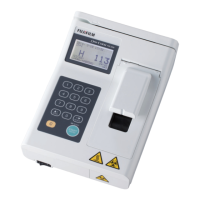
Do you have a question about the FujiFilm DRI-CHEM NX10N and is the answer not in the manual?
| Brand | FujiFilm |
|---|---|
| Model | DRI-CHEM NX10N |
| Category | Laboratory Equipment |
| Language | English |
Defines WARNING, CAUTION, IMPORTANT, and NOTE terms used for safety precautions.
Lists essential precautions before operating the analyzer, including mode distinctions and durability.
Covers safe handling of biohazardous waste and proper disposal procedures for the equipment and consumables.
Warns against using flammable or explosive gases near the equipment.
Details precautions to avoid electrical shock, including power supply and cable handling.
Discusses EMC requirements and user responsibilities for maintaining a compatible electromagnetic environment.
Warns users to keep hands and other items away from moving parts during operation and maintenance.
Specifies environmental and electrical conditions for proper analyzer installation and site selection.
Emphasizes proper diagnosis by considering multiple factors, including analyzer status and quality control.
Provides important usage guidelines for pipettes and tips to ensure accuracy and prevent sample spread.
Details handling precautions for the specific slide types, including storage and usage.
Explains the function of the QC card system for lot compensation and matching cards to slides.
Covers biohazard procedures and safe handling practices for samples like whole blood or plasma.
Provides important notes on handling FUJI CLEAN TIPS, emphasizing tip-end care and storage.
Illustrates and identifies various warning labels found on the FDC NX10N analyzer.
Defines common symbols used in the manual and on the equipment, such as warning, biohazard, and handling icons.
Identifies and labels the main external and internal components of the FUJI DRI-CHEM NX10N analyzer.
Describes the display elements and the functions of the keyboard buttons on the analyzer.
Explains how to load slides into the analyzer, including compensation for lot differences using QC cards.
Details the procedure for preparing a sample and initiating a measurement test on the analyzer.
Describes the measurement process, involving reading plates and calculating substance concentration.
Briefly mentions that used slides are automatically discarded into a disposal box.
Outlines daily maintenance and preparation steps required before turning on the analyzer.
Explains how to perform measurements, including checking readiness, lot matching, and sample preparation.
Provides steps for performing daily maintenance after completing operations, including powering off and cleaning.
Explains the overview and usage of the QC card system for lot compensation and data input.
Details how to connect the analyzer to external devices like a host computer or printer via USB.
Explains how to use the optional sample barcode reader for easy sample ID input.
Describes how sample IDs are automatically displayed, entered manually, or read by barcode reader.
Emphasizes the importance of daily/periodic maintenance for optimal analyzer performance and outlines general warnings.
Details the procedures and precautions for cleaning the photometer, reference plates, and related parts.
Outlines the steps for cleaning the slide loading and transfer parts, including the upper heater.
Explains how to clean the disposal box, including discarding used slides and proper cleaning methods.
Describes the procedure for cleaning the air filter to maintain optimal analyzer temperature and performance.
Introduces the FUJI DRI-CHEM CONTROL QN for performing quality control on the slides.
Instructs users to run the control fluid using the same procedure as patient samples.
Advises defining target values and acceptable ranges for tests using control results.
Explains how to use the control mode for testing and the reset of correlation coefficients.
Provides steps to take if control results are inaccurate, including checking maintenance and fluid handling.
Introduces error codes and test result indications, warning that errors may affect result accuracy.
Describes troubleshooting steps for when the analyzer does not start after the power switch is pressed.
Lists transfer error codes and their causes/solutions, often related to the disposal box or slide transfer parts.
Details photometer error codes and their associated causes and corrective actions.
Details errors related to temperature control issues with the photometer or upper heater.
Details errors related to reading QC cards, including incorrect card types.
Lists power source errors indicating issues with the power supply voltage or AC adapter.
Covers irregular errors that may indicate a circuit board malfunction.
Introduces modes for changing functions and parameters, distinguishing between administrator and normal modes.
Explains the two methods for selecting a mode: scrolling or direct number input.
Describes how to enter administrator mode by inputting a password, allowing access to important functions.
Explains the process of setting the analyzer's date and time, including inputting year, month, and day.
Details how to check routine and control test data, including displaying, transmitting, or printing.
Describes how to input or reset correlation coefficients (a, b) for accurate test results.
Explains how to input lot compensation coefficients (c, d, e) when QC card data is lost or damaged.
Explains how to set reference intervals for tests, including printing current input data.
Describes how to edit sample IDs stored in the analyzer memory.
Details how the analyzer transmits test results to a host computer via USB.
Explains that test results can be printed by an external printer and advises contacting support.
Lists the technical specifications of the FDC NX10N analyzer and its bundled items.
Lists consumables like slides, tips, control fluids, and optional items like a sample barcode reader.
Provides a glossary of abbreviations used in display and printout messages.
